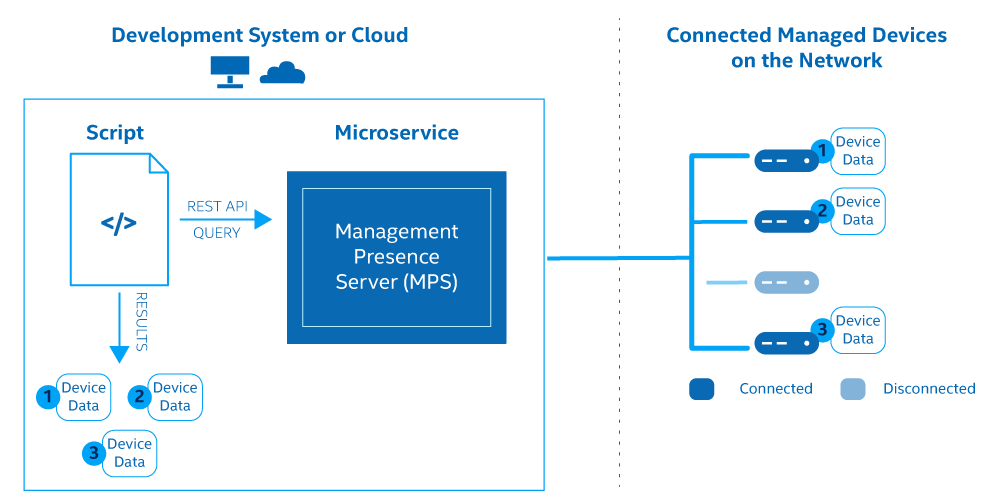REST API Call
This tutorial demonstrates how to construct an Admin method API call for ConnectedDevices using Node.js. The ConnectedDevices method will retrieve information about connected devices, including device GUIDs.
Figure 1: Admin Method API Call for Connected Devices
Note: Successfully deploy the Management Presence Server (MPS) and Remote Provisioning Server (RPS) and connect an Intel® vPro device to MPS before constructing the API call. Start here to install microservices locally or here to install microservices locally with Docker*.
Modify the tutorial template to implement other MPS REST APIs by changing these values:
- method
- payload
- path
View all available MPS methods here.
What You'll Need¶
Hardware
A minimum network configuration must include:
- A Development system with Windows® 10 or Ubuntu 18.04 or newer
- An Activated and Configured Intel® vPro device as the managed device
Software on the Development System
- MPS
- RPS
- Node.js LTS 12.x.x or newer
- Visual Studio Code or any other IDE
What You'll Do¶
The following sections describe how to:
- Construct an Admin API Call to MPS for connected devices
- View Device GUIDs
Construct an Admin Method API Call for Connected Devices¶
1. Navigate to a file directory of your choice.
2. Create and open a new JavaScript file with a name of your choice. In this guide we will refer to it as SampleAPI.js*.
3. Copy and paste the example code below.
4. Replace MPS-Server-IP-Address with the IP Address of your development system or MPS server.
Note: The ConnectedDevices method uses the admin path. MPS methods use either admin or amt as the path. View the difference and all MPS methods here.
Security Information
By running MPS in Dev Mode, authentication is disabled for testing and demonstration purposes. In production, the MPS certificate needs to be signed by a Certificate Authority. Also, an API Key value must be given in the headers of the API request.
Example
Example SampleAPI.js file:
const https = require('https')
process.env['NODE_TLS_REJECT_UNAUTHORIZED'] = 0 //For testing with self-signed certs, remove for production
let postData = {
'method': 'ConnectedDevices', //Retrieve all Devices Connected to MPS
'payload': {
//Some methods such as PowerAction require a payload.
//This one does not as it just retrieves data of all connected devices.
}
}
const options = {
hostname: 'MPS-Server-IP-Address', //Your Development System's IP or MPS Server IP
port: '3000',
path: '/admin', //Supports admin and amt paths. See MPS API Docs for which to use for other different methods.
method: 'POST',
headers: {
'Content-Type': 'application/json',
'X-MPS-API-KEY': 'APIKEYFORMPS123!'
}
}
const req = https.request(options, (res) => {
res.setEncoding('utf8')
res.on('data', (chunk) => {
console.log(chunk)
})
res.on('end', () => {
console.log('No more data in response.')
})
})
req.on('error', (e) => {
console.error(`problem with request: ${e.message}`)
})
// Write data to request body
req.write(JSON.stringify(postData))
req.end()
Execute the REST API¶
1. Open a Command Prompt or Terminal to execute the call.
2. Navigate to the directory you saved the SampleAPI.js file.
3. Run the code snippet using node.
node SampleAPI.js
Example Response:
Important
This is one way to retrieve a device's GUID in the host field. For amt path methods (i.e. Power Actions, Audit Logs, etc), the device GUID is required as part of the POST data. Save this value if you want to try other MPS methods. Other ways to retrieve a GUID can be found here.
Example
Example Command Prompt Output:
response : [{"host":"d12428be-9fa1-4226-9784-54b2038beab6",
"amtuser":"admin","mpsuser":"standalone","icon":1,"conn":1,
"name":"d12428be-9fa1-4226-9784-54b2038beab6"} ]
[{
"host": "d12428be-9fa1-4226-9784-54b2038beab6",
"amtuser": "admin",
"mpsuser": "standalone",
"icon": 1,
"conn": 1,
"name": "d12428be-9fa1-4226-9784-54b2038beab6"
}]
Construct Other MPS Methods¶
To adapt the above code snippet to work with a different MPS method of your choice, follow the below steps.
-
Select a method from the MPS API Documentation
-
Update the method field in postData with the name of the method.
-
Copy and paste the payload if the method requires it. If necessary, replace the guid field inside the payload with the AMT device's GUID.
-
Update the path field to either /admin or /amt
-
Save and run the Javascript file.
Example
Highlighted fields should be updated:
const https = require('https')
process.env['NODE_TLS_REJECT_UNAUTHORIZED'] = 0 //For testing with self-signed certs, remove for production
let postData = {
'method': 'ConnectedDevices', //Retrieve all Devices Connected to MPS
'payload': {
//Some methods such as PowerAction require a payload.
//This one does not as it just retrieves data of all connected devices.
}
}
const options = {
hostname: 'MPS-Server-IP-Address', //Your Development System's IP or MPS Server IP
port: '3000',
path: '/admin', //Supports admin and amt paths. See MPS API Docs for which to use for other different methods.
method: 'POST',
headers: {
'Content-Type': 'application/json',
'X-MPS-API-KEY': 'APIKEYFORMPS123!'
}
}
const req = https.request(options, (res) => {
res.setEncoding('utf8')
res.on('data', (chunk) => {
console.log(chunk)
})
res.on('end', () => {
console.log('No more data in response.')
})
})
req.on('error', (e) => {
console.error(`problem with request: ${e.message}`)
})
// Write data to request body
req.write(JSON.stringify(postData))
req.end()
Other Methods¶
The sample Node code snippet can be adapted for other MPS and RPS methods. To learn more, see:
Explore the UI Toolkit¶
In addition to REST API calls, the Open AMT Cloud Toolkit provides a reference implementation console. Add manageability features to the console with prebuilt React components, such as Keyboard, Video, and Mouse (KVM).
